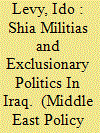| Srl | Item |
| 1 |
ID:
181751


|
|
|
|
|
| Summary/Abstract |
This paper examines the funding sources of the terrorist group Harakat al-Shabaab al-Mujahideen. Using existing research and original interviews, this study outlines al-Shabaab’s history and funding sources. It theorizes that an organization’s capacity to operate in different fields of economic activity drives innovation in funding. Applying a framework for terrorist innovation to al-Shabaab’s funding sources, this study finds support for the theory. Development of intelligence and taxation capabilities is especially prevalent in the al-Shabaab context. Holding territory considerably increases organizational ability to raise funds. Increasing reliance on criminality may compromise an organization’s ideological character and leave it more vulnerable to inter-group competition.
|
|
|
|
|
|
|
|
|
|
|
|
|
|
|
|
| 2 |
ID:
191017


|
|
|
|
|
| Summary/Abstract |
Open-source data and studies indicate the higher lethality rates of jihadist groups versus other types of terrorist organizations. I argue jihadist groups are more lethal than other groups due to their higher ideological intensity, determined by observing how ideology corresponds to a group’s goals, internal cohesion, and external affinity. I use data from the Global Terrorism Database (GTD) and Revolutionary and Militant Organizations dataset (REVMOD) to create two samples of terrorist organizations coded by ideological affiliation. My findings confirm the higher lethality of jihadists in general and of apocalyptic jihadists in particular. Jihadist groups kill more per attack and have higher kill-wound ratios than other groups. Attachment to suicide terrorism largely accounts for higher jihadist lethality.
|
|
|
|
|
|
|
|
|
|
|
|
|
|
|
|
| 3 |
ID:
169608


|
|
|
|
|
| Summary/Abstract |
Following the May 12, 2018, parliamentary elections in Iraq, the lists of two prominent militia heads have emerged victorious. The Saairoon Alliance came in first, with 54 of the 329 seats, while the Fatah Alliance took second, with 47. Muqtada as‐Sadr, the Shia cleric and leader of the militia Saraya as‐Salam, and Hadi al‐Amiri, commander of the Badr Organization, head Saairoon and Fatah, respectively.1 These results reflect the widespread support the militias of al‐Hashd ash‐Shaabi, the Popular Mobilization Units (PMUs), have accumulated in their efforts against the Islamic State (IS) terrorist organization. Some PMUs want to assist the military in restoring the government's full control over Iraqi territory and even be incorporated into the military and police. Others receive support from Iran and openly proclaim loyalty to its supreme leader.
|
|
|
|
|
|
|
|
|
|
|
|
|
|
|
|